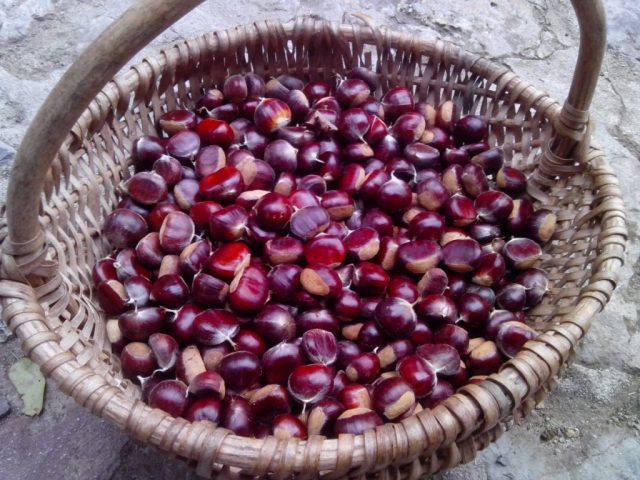
Autumn, part 2
Last time I already wrote about the grape harvest, the »Trgatev« so now a little bit about the other association with autumn: Chestnuts. Bine’s birthday (October 7) always coincides with the chestnut season and so they are almost always roasted and eaten with our visitors on that day. This year, however, Bine did not want to celebrate his birthday, but we have already eaten chestnuts ….. in the village. A few neighbors had already gathered a bunch. We usually meet with a number of neighbors to roast chestnuts. Whoever has gathered them will call the rest to invite them over.

By the way, no sweet chestnuts grow in our immediate vicinity. We have to drive for about 20 minutes, but it’s always worth our while. We have two regular places where we always go. Usually, we go about two or three times to collect them so that we have a few kilos together. We are of course not the only ones who do this so sometimes it takes a lot of searching J. Sometimes there are only empty shells left everywhere. It also depends on the year. Some years there are many of them, sometimes less, or the chestnuts are smaller than other years. The large ones are the best and also the easiest to peel.

When we have enough, a BBQ or fire basket is lit and the chestnuts are slightly incised on one side with a knife so that they do not “explode” when they are roasted. On a plate with holes in it, the chestnuts are then roasted on the BBQ over the open fire. Not too much in one go and they should always be ‘stirred’ well so that they are roasted on all sides. After about 15 minutes they are ready and they are thrown into a bowl or a cardboard box. Then the peeling and feasting can begin :).

Because the chestnuts are roasted over open fire, they are heavily charred and you get nice black hands from peeling them. But they are delicious! Especially the first round of course. Usually there are a few more rounds in one or two weeks, but the first one is always the best;).

You can also cook the chestnuts by the way. Just in a pan with water and some salt. They can be boiled in the skin and then peeled or, probably easier, peeled first and then cooked. This is also nice, but it lacks the charm of standing outside around a fire together ;).
Eating chestnuts inevitably includes drinking »Mošt«. This is the (turbid) juice from the freshly picked grapes that has started to ferment. It is then no longer grape juice and therefore not sweet. But it is also not wine yet because it is still too early for that. According to an old folk tradition, the mošt turns into wine on November 11. Here it is called »Martinovanje«, in the Netherlands, it is the Sint Maarten celebration (St. Martin’s day). In any case, the mošt is very sour and I don’t like it, but here it is a habit to drink it with the chestnuts. And yes, you can already get drunk from it, hahaha.

No Comment